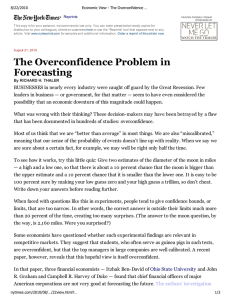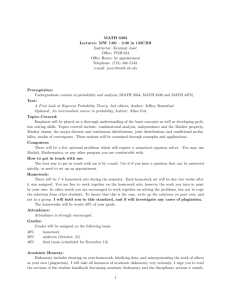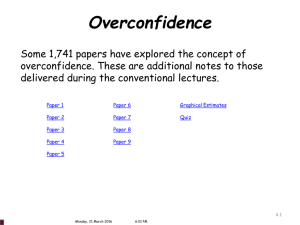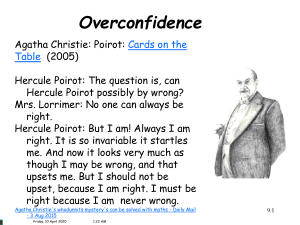Reliability and Safety
advertisement
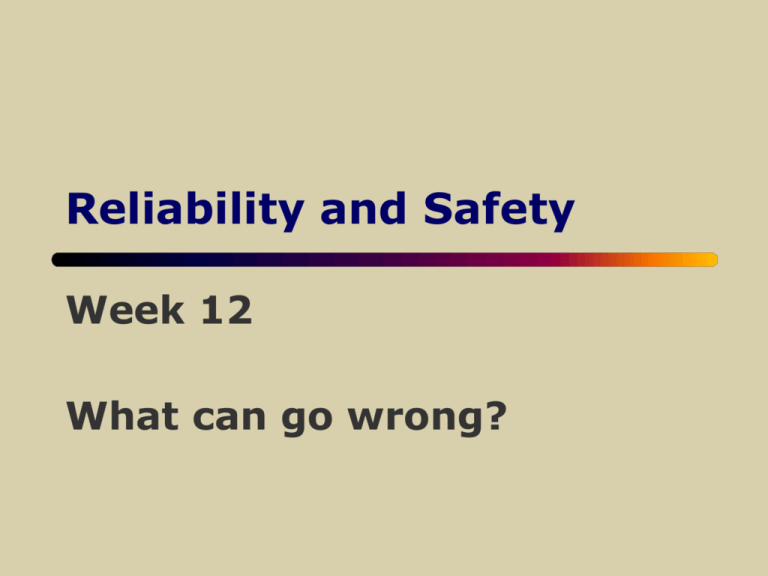
Reliability and Safety Week 12 What can go wrong? Issues: Hardware Errors Software Errors Fault vs Error Computer failure causes: Faulty design Sloppy implementation Careless or insufficiently trained users Poor user interfaces Hardware/Software malfunctions Specification errors Scope/Application inconsistency Computer users perspective Should understand limitations of the computers Need for proper training Need for responsible use Difference between good products and bad ones Computer Professional Perspective Study computer failures Study computer ethics Educated Member of Society Perspective Help us evaluate the reliability and safety of various computer applications Help evaluate computer technology Three Categories of Failures Problems for individuals System failures that affect large numbers of people or cost large amounts of money Problems in safety-critical applications Problems for Individuals Billing Errors design and/or implementation of programs Not enough care - input error Not enough testing reasonable range Not enough training Database Accuracy Problems Info in database is not accurate Automatic entering of info mistakes can be overlooked Copies of incorrect info can be sent to other systems Not knowledgeable enough about the system Causes Large population Most of our financial interactions are with strangers Automated processing without human common sense Overconfidence in accuracy of data Lack of accountability Consumer Hardware and Software Usually have more serious errors in their first releases Regularly sold with known bugs Hardware also has flaws tradeoff between cost, debugging, and marketing Dishonesty, denials of problems, lack of adequate response to complaints System Failures Lots of $$$$ Complete shutdown of basic services Areas: communications Business and financial systems Military WHY? Not enough testing Technical difficulties Poor management decisions Dishonesty in promoting the system and responding to problems Communications Phone Service How Bad? pagers phone calls 911 Communications for airports cellular phones Business and financial systems Stock exchange ATM Contest by Pepsi too many winning tickets issued Destroying Business Loss of sales incorrect info affects business dissatisfied customers incorrect prices loss of data Military Data management Weapons system design Battle simulation Battle management command/control communications intelligence Nuclear war Why? Not enough testing technical difficulties poor management decisions dishonesty in promoting the system and responding to problems Results in delays and abandonment of projects Heard Before? The Denver Airport baggage system Outbound luggage checked at ticket counters or curbside to be delivered to anywhere in <10 minutes via automated system of cars on tracks connecting flights or terminals Laser scanners tracks - 4000 cars Problems Encountered Cars crash into each other at intersections Luggage misrouted, dumped or flung Needed cars were idle or put to rest Specific problems Real world problems scanners got dirty knocked out of alignment Software error rerouting of cars to waiting area - idle Causes Time allowed for development and testing was insufficient Significant changes in specifications were made after project began Not enough debug time Poor management Unrealistic plan Safety Critical Applications Use of computers is increasing rapidly in these areas Use of computers in these areas can save $ Areas Military Medical Applications Power plants Aircraft Trains Aircraft - Fly by Wire Pilots do not directly control plane Actions are input to computers that control the aircraft systems Pilot interaction is critical Need for easy way to override computers Easy transfer between automatic and manual control Air Traffic Control Long delays Increased risk of collisions Old machines - computer systems Political - government spends $ elsewhere Case Study - Therac-25 Software controlled radiation therapy machine used to treat people with cancer Problems: Massive overdoses administered Repeated overdoses due to faulty display Death Operated in dual machine mode electron beam or x-ray photon beam Why? Lapses in good safety design Insufficient testing Bugs in software that controlled machines Inadequate system of reporting and investigating accidents and deaths Specific problems Some hardware safety features were eliminated in newer models Software used was assumed correct from older systems Malfunctioned frequently Weakness in design of operator interface inadequate explanation of error messages if any Specific problems continued Machine allowed one-key intervention versus automatic shutdown Inadequate documentation Poor test plan Software Errors - bugs Fatal error was a simple fix Fixes are complex, expensive, and prevents use of machine while fixing Bugs can be intermittent and hard to detect importance of self checking importance of using good programming techniques Overconfidence Leaving out changes that are necessary Ignoring error messages Not using backup devices (video or audio) Conclusion and Perspective Irresponsibility leads to criminal charges Responsibility leads to merit awards Importance of good software development Consequences of carelessness, cutting corners, unprofessional work, or attempts to avoid responsibility Lack of appreciation for risks Poor training Ways to prevent problems Good computer systems Good training Accountability Individual responsibility Management responsibility IEEE Code of Ethics Increasing Reliability and Safety What goes wrong? Many lines of code and many programmers Problems are managerial, technical, social, legal, ethical Overconfidence Unappreciative of risks Ignore warnings Don’t consult manuals Professional Techniques Use good software engineering techniques at all stages of development: Requirements Specs design implementation documentation testing Professional Techniques Study the techniques and tools available Knowing or learning enough about the application field and the software or systems being used Why Study Failures? Provides technical lessons Leads to improved hardware and software products Provide ethical data Lead to improved ethical codes/laws Lessons Learned Accidents are not the result of unknown scientific principles but rather a failure to apply wellknown engineering practices Accidents will not be prevented by technological fixes alone, requires control of all aspects of the development and operation of the system Lessons Learned Software developers need to recognize the limitations of software, and use hardware safety mechanisms Redundancy and Selfchecking Redundancy - judging - expensive Complex systems collect information to diagnose and correct errors Audit trails are vital Detail records help protect against theft and help trace and correct errors Redundancy and Selfchecking Designed to constantly monitor itself and correct problems automatically Half of the computing power is devoted to checking The rest for errors closes off part of the system reroutes corrects problems and reroutes again TESTING CRITICAL! Principles and techniques exist can use another company to perform Independent verification and validation Dangerous Tendencies Operators bypass check mechanisms through familiarity Technicians Blame random mechanical or signal glitches rather than software Corporate Managers Initially deny and ignore - then cover up Finally - deal with expensive fixes Overall Lessons Learned Should not declare problem understood with first hypothesis Should not expect management to follow through on field reports Overconfidence in software leads to economical marginal designs Overall Lessons Learned Enforcement of software engineering practices is often abysmal Basing risk assessments on individual subsystems often leads to unrealistic optimism Lessons for systems engineering Hardware backups valuable Software must not be presumed innocent Audit trails are critical Risk estimates are subjective User feedback is valuable Lessons for software engineering Documentation should be on-going Designs should be kept simple Testing should be built into software Software must be tested out of system and in system Reuse of software should be tested like new software Lessons for oversight Users are more likely to make initial observations than monitoring officials Users need reliable information in order to be maximally valuable Laws and Regulations Criminal and Civil penalties Suits against company that designs or sells the system Criminal charges when fraud or criminal negligence occurs Need contracts Need well designed laws and standards Regulation Requirement for approval by a government agency before a new product can be sold including specific testing requirements The profit motive causes skimping on safety Better to abandon in some cases Inadequate abilities to judge by customer Hard to sue large companies Regulation Expensive and timeconsuming Newer procedures may not be enforced Lots of paperwork Professional licensing Licensing of software development professionals to protect against poor quality and unethical behavior Specific training Passing competency exam Ethical requirements Continuing education



